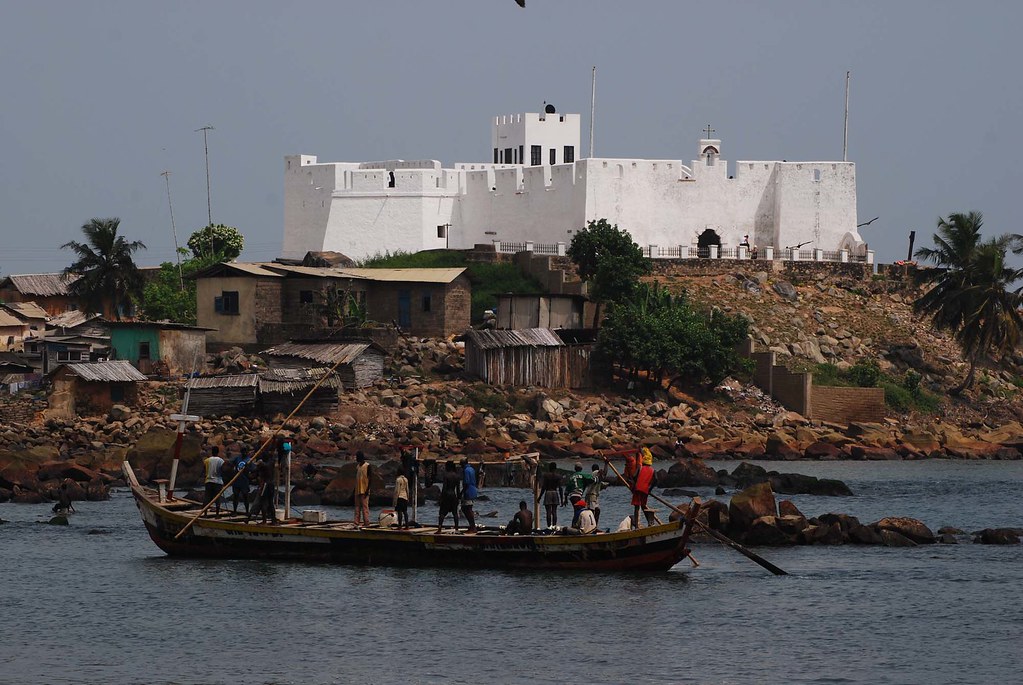
Fort Metal Cross - Dixcove
In the 1680's, the Ahantaland around Inhuman settlement was a bone of contention between the English and the Brandenburg. The English were determined to acquire land there to build a fort because many English interloper captains were accustomed to trading at Fort Gross Fredericksburg to the detriment of English commerce.
The chief of Upper/Greater Dixcove leased to the English a promontory site near Inhuman village, located on the shore of a large and sheltered bay, later designated as Dick's Cove (Dixcove). The Cove's calm waters and sandy beach made it an ideal "harbour" for canoes and small boats while ships could anchor about 3 kilometres offshore. The Royal African Company commenced construction of the fort in 1692 but was unable to complete it until 1698 because of spasmodic attacks by the Ahanta people which continued well into the 18th century on account of the presence of the Dutch fort Babenstein at Butre.
The original fort, as seen and described by writers like Jean Barbot, was square with a pointed bastion at each corner except for the southwest corner which had a round tower. Curtain walls linked the bastions and tower. The inner structure comprised apartments, storage rooms and kitchen arranged round a small courtyard. Subsequently there were several alterations to the original structure: a spur ending with a bastion, which was constructed in the 1St century, consisted of garrison apartments storage rooms and a workshop. One of the hollow bastions in the main section of the fort was employed as a slave prison. By 1750, the fort was equipped to carry up to 25 canons. [http://www.ghanaexpeditions.com/regions/highlight_detail.asp?id=&rdid=125]
Fort Metal Cross, Dixcove (1692)
The British colonial fortification, Fort Metal Cross (originally Dixcove Fort) is located on a promontory near the fishing village of Infuma, in Dixcove (Dick’s Cove) in the Western Region of Ghana. The cove’s quiet waters are suitable for small boats and canoes; large ships anchor approximately 2 kilometres offshore.
For the British, the motive for commencing construction of Dixcove Fort in 1692 was identical to that of the Dutch in building Fort Batentstein - to tap into the promise of gold in the hinterland; and also to win back the many English captains trading at the Brandenburgers’ (Germans’) Fort Gross Friedrichsburg in nearby Princestown. However, the people of Infuma, loyal to two chiefs whose allegiances swayed between the British and Dutch, besieged the fort several times, on behalf of the Dutch, stalling its completion. By 1750, the fort was equipped to carry up to 25 canons.
The promise of gold never materialised, as the gold that was mined was largely impure gold. Hence, the fort earned the title of ‘the fake mint of the Gold Coast’ by author Bosman. Like Fort Batentstein, Fort Metal Cross became a service-station for the repair of ships and the supply of timber from the surrounding forest; and during the slave trade, it became a slave prison.
The 1867 fort exchange agreement between the British and Dutch resulted in Dutch ownership of the fort in 1868. The Dutch had to call for military reinforcement to restore calm in their new areas of control, as the local populace was infuriated by the swap, especially since they had not been consulted. The name of the fort was altered to ‘Metalen Kruis’ (Metal Cross), after one of the Dutch gun-boats which brought the reinforcement.
However, the immense cost of control persuaded the Dutch to sell their forts to the British. Hence, in 1872 the fort reverted to the British, who renamed it Fort Metal Cross.
The fort has served both the Police and the Postal Services. It has currently been leased to a private organization. The fort’s opening hours are 9:00am to 4:30pm. (source: Ghana Museums)






0 comments:
Post a Comment